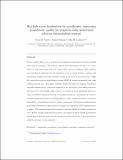Brackish water desalination for greenhouses: Improving groundwater quality for irrigation using monovalent selective electrodialysis reversal
Author(s)
Ahdab, Yvana D; Rehman, Danyal; Lienhard, John H
Downloadneosepta_journal_paper.pdf (6.538Mb)
Open Access Policy
Open Access Policy
Creative Commons Attribution-Noncommercial-Share Alike
Terms of use
Metadata
Show full item recordAbstract
Reverse osmosis (RO) is the most widely used desalination technology for treating brackish water prior to irrigation. RO, however, removes both monovalent ions (Na+,Cl−) detrimental to crops and divalent ions (Ca2+,Mg2+,SO42−) that are beneficial. These beneficial ions must then be reintroduced to the desalinated water by adding fertilizer or mixing with nutrient-rich brackish water that typically contains excess levels of monovalent ions. Unlike RO, monovalent selective electrodialysis reversal (MSED-R) removes monovalent ions, while retaining divalent ions. This paper evaluates whether Neosepta ion exchange membranes, originally manufactured to concentrate seawater for salt production, show sufficient monovalent selectivity in the brackish salinity range to be suitable for use in greenhouse agriculture. Using an MSED-R experimental set-up, 16 brackish groundwater compositions are tested to determine membrane parameters, including limiting current, membrane resistance, membrane permeability, and membrane selectivity. Across compositions, the Neosepta membranes show monovalent selectivity for sodium relative to calcium and magnesium and for chloride relative to sulfate. The membrane selectivities are used to calculate MSED-R fertilizer savings relative to RO for brackish groundwaters across the U.S. Regions in which brackish groundwaters contain greater than the target nutrient concentrations for crop growth, or show potential for MSED-R adoption, are also identified.
Date issued
2020-09Department
Massachusetts Institute of Technology. Department of Mechanical Engineering; Massachusetts Institute of Technology. Department of Civil and Environmental Engineering; Rohsenow Kendall Heat Transfer Laboratory (Massachusetts Institute of Technology)Journal
Journal of Membrane Science
Publisher
Elsevier BV
Citation
Ahdab, Yvana D. et al. "Brackish water desalination for greenhouses: Improving groundwater quality for irrigation using monovalent selective electrodialysis reversal." Forthcoming in Journal of Membrane Science 610 (September 2020): 118072 © 2020 Elsevier B.V.
Version: Author's final manuscript
ISSN
0376-7388